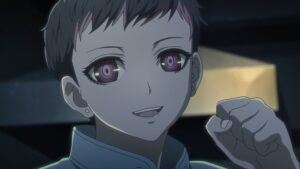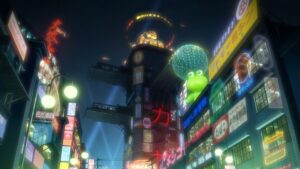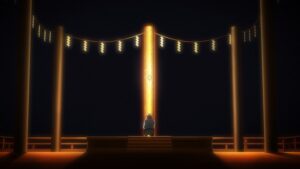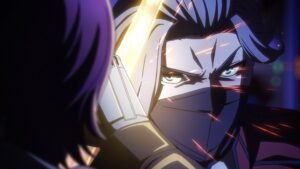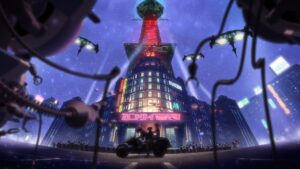On the surface, Akudama Drive is far from my cup of tea. It’s a spectacle-first production that operates on the fringes of sanity, working with characters so thin that their names and occupations are one and the same. There was fun to be had in its early episodes (particularly the never-ending parade of carnage that was the premiere), but its adherence to heist and escort mission templates made it feel safer than such an otherwise-daring series should have felt.
That all changed in the series’ sixth week, which doubled as one of the year’s best action showcases and a statement on the futility of violence. From that point on, the show raised the stakes with each episode, quickly fraying the fabric of its dystopian setting and treating its characters’ decisions as major milestones. Akudama Drive was headed somewhere important – a belief that was justified by a finale that managed to be both catastrophic and hopeful. There were bumps in the road along the way, and we’ll talk about those, but overall the series gets a definite recommendation from me.
Let’s talk about characters, since their presentation varies between the show’s two halves. Both the criminal class Akudama and their Executioners are given psychedelic intro cards, marking them as badass lunatics – and then there’s our protagonist, Swindler. She spends half the series exhibiting Headless Chicken Syndrome, having disguised herself as another lunatic in a bid to escape an impossible situation. She’s utterly unconvincing in the role, a problem which Akudama Drive sidesteps via the stupidity of her companions, but her transparency is still a problem for the audience at first. As her circumstances become more desperate, however, she finds a strong identity as a protector of those even weaker and more desperate than herself, and undergoes one of the best late-stage character evolutions in recent memory. I typically don’t hesitate to spoil in series reviews, but I’ll make an exception in this case – her transformation really should be experienced blind.
As for all the other nutcases, they’re tons more fun than Swindler at first. Meatheads like Brawler and Master are given life by boisterous voice acting and striking fight choreography, while specialists like Hacker and Doctor are driven by insatiable thirsts for entertainment and control, respectively. Doctor in particular undergoes the second most significant change after Swindler, but moves in the opposite direction, manipulating others for her own gratification instead of acting in their interest. It’s my opinion that the contrast between the two women wasn’t sufficiently emphasized, which is an issue with a lot of character pairings. The bond between Hoodlum and Brawler, for example, was often treated as a cornerstone of the entire cast, but in retrospect their friendship was propped up by a series of gags and not much else. Swindler’s influence on Courier, too, resulted in a huge payoff without much legwork – though his role in the final episode was so riveting that I can forgive that emotional leap.
Akudama Drive, more than most series, is one where some episodes are worlds better than others. This fluctuation is a large part of what keeps the show from greatness, as it manifests in both the story and the visual presentation. I’ve already mentioned the familiarity of the heist and escort missions, but even within these pedestrian plots the gaps between good and bad material were vast. Showdowns between the Akudama and Executioners could burst with energy in one episode, then fail to make good use of an inventive set piece two weeks later, and circle around to time-warping fluidity two weeks after that (I really can’t recommend episode 6 highly enough). Character art took some major hits during the show’s less impressive outings, as well; I suspect that director Tomohisa Taguchi and his production desk kept their top and bottom talent segregated for this project. Was it wise to use such a stark method of resource allocation for a setting that already strained believability? The answer will boil down to your stance on the old ‘consistency vs peak’ debate.
One thing we can be sure of is the series’ overall vision, which I questioned at several points during its run. Why did Hacker split from the rest of the group in episode 5? Why all the details about the war between Kansai and Kanto, given the latter’s minimal involvement in the story? As Akudama Drive barreled toward its conclusion, it provided satisfactory (if hurried) answers to most of these queries. I may not understand the reason for that damned rocket ship, but it’s clear now that everything to do with Kanto and the civilian riots was a setup for a larger point about the dangers of institutional corruption and authoritarianism. The finale played host to several large-scale shootouts, but they weren’t included simply to meet a laser beam quota. They paved the way for the show’s two most vulnerable characters to escape Kansai’s oppressive technocracy – the most fitting ending that a bloody yet socially conscious story like this one could have been given.
A couple of final notes before I go. One, Akudama Drive’s soundtrack is among the loudest and most visceral of the year. Its blend of hard rock and pulsating electronica propels already-gripping fight scenes into feverish territory, and chiming piano pieces are included to accompany the show’s rare contemplative side. In a rare move for TV anime, there is at least one new song in every episode, which is what puts the whole thing over the top in my eyes. Two (and this has nothing to do with Akudama Drive), this is the last numerical score I’ll be giving on this site. I’ve hated the practice for years, but have stuck with it until now to match our house style. After three and a half years here at Star Crossed, I think I’ve got the necessary blogger cred to kick the habit. Consider it a resolution for the upcoming year if you must! Hope everyone has a merry New Year’s Eve and an even better 2021 – take care.

